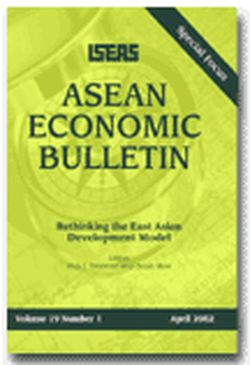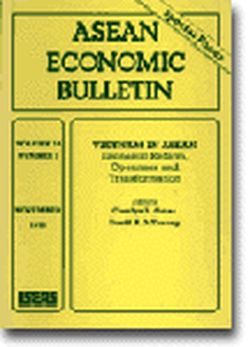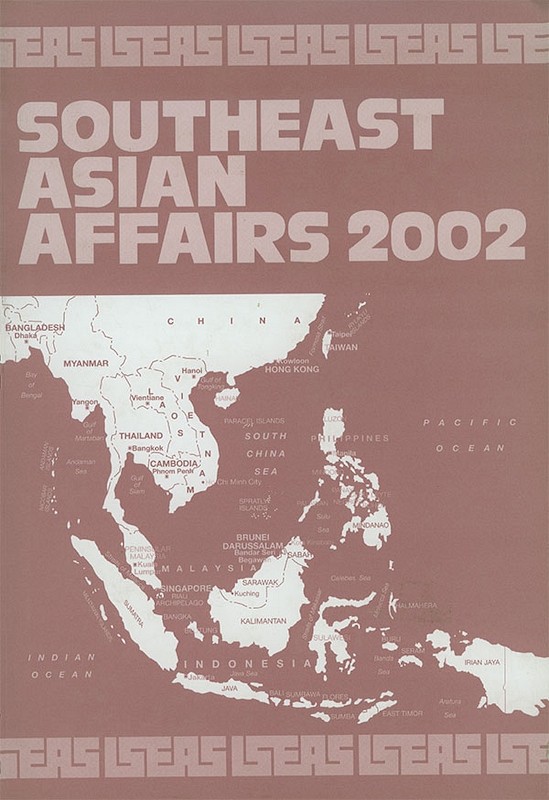ASEAN Economic Bulletin Vol. 19/1 (Apr 2002). Special Focus on "Rethinking the East Asian Development Model"

Date of publication:
April 2002
Number of pages:
126
Code:
AE19/1
Contents
-
ASEAN Economic Bulletin Vol. 19/1 (Apr 2002). Special Focus on "Rethinking the East Asian Development Model"
-
Preliminary pages
- ARTICLES
-
1. Introductory Overview: Rethinking the East Asian Development Model, by Nick J Freeman, Denis Hew Wei-Yen, authors see abstractIntroduction to the Special Focus Issue of ASEAN Economic Bulletin Vol. 19, No. 1 (April 2002)
-
2. Remodelling East Asian Development, by Shahid Yusuf, author see abstractThe East Asian crisis of 1997-98 and subsequent research have highlighted how policies and institutions in East Asia need to evolve, in order to build on acquired strengths and momentum, to remedy apparent weaknesses, and to come to terms with global integration. The resumption of rapid growth will require more emphasis on innovation systems, the development of the financial and IT sectors and possibly the effective, regionally coordinated use of fiscal and exchange rate policies. It also requires a significant change in the role of the government with respect to industrial policy, ownership, and regulation.
-
3. Rethinking the Southeast Asian Development Model: Bringing Ethical and Governance Questions in, by Richard A Higgott, Helen E S Nesadurai, authors see abstractThis article argues that the Southeast Asian development model (SEADM), as practised in parts of Southeast Asia, reflected an overwhelming emphasis on growth as a goal, while neglecting issues of equity and justice. This was clearly seen in the Thai and Indonesian experiences, where rising growth rates and income levels under open/free market policies were accompanied by widening income and wealth disparities, as well as growing feelings of marginalization, deprivation, and of injustice among large segments of the local population. In both countries, these developments led to growing challenges to the open market system well before the regional financial crisis. Yet, rethinking the SEADM does not mean doing away with open market policies. Instead, approaches to development must take seriously the goals of equity and social justice, to overcome the danger of open conflict and societal resistance that will likely emerge to challenge the very policies that have the best chance of delivering economic well-being over the long run.
-
4. Rethinking the Role of Agriculture in the "East Asian" Model: Why is Southeast Asia Different from Northeast Asia?, by Anne Booth, author see abstractThis article asserts that the "Asian model" of egalitarian agricultural development is based on the experience of only very few Asian countries, especially Taiwan. In fact, the agricultural development which has occurred in much of Southeast Asia since the 1960s has been less egalitarian than in Taiwan, precisely because it has taken place in the context of an unreformed or partially reformed agrarian structure, where the distribution of land and incomes are more skewed, the labour intensity of agricultural production is lower, and linkages between on-farm and off-farm income growth are less pronounced. The article examines growth in agricultural output, the distribution of land, labour absorption in agriculture, linkages between growth in agricultural incomes and non-agricultural incomes, and changing patterns of rural employment and household income in the Southeast Asian context, and outlines the future direction of rural development policies.
-
5. Structural Changes in International Industrial Linkages and Export Competitiveness in the Asia-Pacific Region, by Chiharu Tamamura, author see abstractThis article analyses how the industrial structures of Asian countries changed quantitatively during the period 1985 to 1995, using an international input-output analysis. The focus is on the changing patterns of demands of origin and of patterns of procurement for production for the manufacturing sector. The electric/electronics and transportation equipment sectors are given particular emphasis in the examination. In addition to this analysis, the article measures the export competitiveness of each country, which has changed along with changes in international industrial linkages after the crisis with the use of the indices for RCA (Revealed Comparative Advantage), TSC (Trade Specialization Coefficient), and export share in the world market. Through this analysis, two important findings emerge. The first is that the Asian countries are more competitive than complementary in terms of the international division of labour. The second is that local supporting industries in the transportation sector in Asia (except Japan) have not been nurtured for more than a decade.
-
6. Bridging the Digital Divide in Southeast Asia: Pilot Agencies and Policy Implementation in Thailand, Malaysia, Vietnam, and the Philippines, by Frank B Tipton, author see abstractGovernments in both the developed and the developing worlds are struggling to come to terms with the challenges of the information age. In the case of the developing world the challenges include the need to overcome the digital divide that threatens to widen the gap between rich and poor. New agencies have been created to speed the implementation of information and communications technology (ICT) and to address digital divide issues. This provides an opportunity to re-examine the concept of pilot agencies as organs of the developmental state. This article looks at the new government organs in Thailand, Malaysia, Vietnam, and the Philippines in a comparative framework, using China and Singapore as ends of a spectrum of size and development. The challenges are formidable, and as yet, these new organs have not developed into pilot agencies able to pursue independent agendas or force the pace of adoption of ICT, but the pilot agency framework provides a useful benchmark for analysis and may offer models for future institutional innovation.
-
7. The Challenge of Technological Development for ASEAN: Intraregional and International Co-operation, by Dimitrios Konstadakopulos, author see abstractThe development of science and technology has been a familiar issue in the context of ASEANs economic growth. The aim of this article is to acquire a better understanding of the institutional frameworks for technological policy formulation and implementation within ASEAN since the 1997 financial crisis. It also attempts to re-evaluate the political and institutional preconditions necessary for the technological advancement of ASEAN in the early twenty-first century.
-
8. The ASEAN Surveillance Process and the East Asian Monetary Fund, by Worapot Manupipatpong, author see abstractSince the East Asian crisis in 1997-98, regional finance co-operation has gathered pace, both in ASEAN and East Asia (under the ASEAN Plus Three framework). This article reviews the development of regional surveillance and self-help and support mechanisms, through the establishment and operation of the ASEAN Surveillance Process and the Chiang Mai Initiative, respectively. Such developments could potentially lead to the establishment of an East Asian Monetary Fund.





